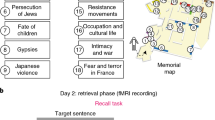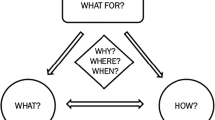Abstract
This paper summarizes and discusses three studies of patterns in the recall of persons in socially bounded communities. Individual sin three different communities (a graduate academic program, a religious fellowship, and a department in a formal organization) free-listed the names of persons in their respective communities. Results indicate that the individuals in each community share a common cognitive structure of community members that is based on the community’s social structure. These studies, combined with the results of other research, strongly suggest that persons are organized in memory according to social structural principles and that affiliation and dominance are the principal dimensions of social cognition. Suggestions are offered for future research to test the generality of these findings.
Similar content being viewed by others
References
Alexander, J. 1976 A Study of the Cultural Domain of “Relatives.”American Ethnologist 3:17–38.
Arabie, P. 1984 Validation of Sociometric Structure by Data on Individuals’ Attributes.Social Networks 6:373–403.
Bahrick, H. P., P. O. Bahrick, and R. P. Wittlinger 1975 Fifty Years of Memory for Names and Faces: A Cross-sectional Approach.Journal of Experimental Psychology: General 104:54–75.
Bernard, H. R., and P. D. Killworth 1977 Informant Accuracy in Social Network Data II.Human Communication Research 4:3–18.
Bernard, H. R., P. D. Killworth, and L. Sailer 1982 Informant Accuracy in Social Network Data V. An Experimental Attempt to Predict Actual Communication from Recall Data.Social Science Research 11:30–66.
Bjorklund, D. F., and B. R. Zeman 1983 The Development of Organizational Strategies in Children’s Recall of Familiar Information: Using Social Organization to Recall the Names of Classmates.International Journal of Behavioral Development 6:341–353.
Bond, C. F., Jr., and D. R. Brockett 1987 A Social Context-Personality Index Theory of Memory for Acquaintances.Journal of Personality and Social Psychology 52:1110–1121.
Bond, C. F., Jr., and C. Sedikides 1988 The Recapitulation Hypothesis in Person Retrieval.Journal of Experimental Social Psychology 24:195–221.
Bond, C. F., Jr., R. L. Jones, and D. L. Weintraub 1985 On the Unconstrained Recall of Acquaintances: A Sampling-Traversal Model.Journal of Personality and Social Psychology 49:327–337.
Boster, J. S., J. C. Johnson, and S. C. Weller 1987 Social Position and Shared Knowledge: Actors’ Perceptions of Status, Role, and Social Structure.Social Networks 9:375–387.
Bousfield, W. A. 1953 The Occurrence of Clustering in the Recall of Randomly Arranged Associates.Journal of General Psychology 49:229–249.
Breiger, R. L., and J. G. Ennis 1979 Personae and Social Roles: The Network Structure of Personality Types in Small Groups.Social Psychology Quarterly 42:262–270.
Brewer, D. D. 1993 Patterns in the Recall of Persons in a Student Community.Social Networks 15:335–359.
1995 Patterns in the Recall of Persons in a Department of a Formal Organization.Journal of Quantitative Anthropology, in press.
Brewer, D. D., and B. L. Yang 1994 Patterns in the Recall of Persons in a Religious Community.Social Networks 16:347–379.
Brown, R. 1965Social Psychology. New York: Free Press.
Buchanan, J. P., T. V. Gill, and J. T. Braggio 1981 Serial Position and Clustering Effects in a Chimpanzee’s “Free Recall.”Memory and Cognition 9:651–660.
Burt, R. S. 1986 A Note on Sociometric Order in the General Social Survey.Social Networks 8:149–174.
Burt, R. S., and W. M. Bittner 1981 A Note on Inferences Regarding Network Subgroups.Social Networks 3:71–88.
Buss, D. M. 1995 Evolutionary Psychology: A New Paradigm for Psychological Science.Psychological Inquiry 6:1–30.
Byrne, R. W., and A. Whiten, eds. 1988Machiavellian Intelligence: Social Expertise and the Evolution of Intellect in Monkeys, Apes, and Humans. Oxford: Oxford University Press.
Cairns, R. B., J. E. Perrin, and B. D. Cairns 1985 Social Structure and Social Cognition in Early Adolescence: Affiliative Patterns.Journal of Early Adolescence 5:339–355.
Chan, A. S., N. Butters, J. S. Paulsen, D. P. Salmon, M. R. Swenson, and L. T. Maloney 1993 An Assessment of the Semantic Network in Patients with Alzheimer’s Disease.Journal of Cognitive Neuroscience 5:254–261.
Cheney, D. L., and R. M. Seyfarth 1990How Monkeys See the World. Chicago: University of Chicago Press.
Dasser, V. 1988a A Social Concept in Java Monkeys.Animal Behavior 36:225–230.
1988b Mapping Social Concepts in Monkeys. InMachiavellian Intelligence: Social Expertise and the Evolution of Intellect in Monkeys, Apes, and Humans, R. Byrne and A. Whiten, eds. Pp. 85–93. Oxford: Oxford University Press.
Delfosse, P., and P. K. Smith 1979 Memory for Companions in Preschool Children.Journal of Experimental Child Psychology 27:459–466.
Fischer, C. S. 1982To Dwell among Friends. Chicago: University of Chicago Press.
Fiske, A. P. 1993 Social Errors in Four Cultures: Evidence about Universal Forms of Social Relations.Journal of Cross-Cultural Psychology 23:463–494.
1995 Social Schemata for Remembering People: Relationships and Person Attributes in Free Recall of Acquaintances.Journal of Quantitative Anthropology, in press.
Fiske, A. P., N. Haslam, and S. T. Fiske 1991 Confusing One Person with Another: What Errors Reveal about the Elementary Forms of Social Relations.Journal of Personality and Social Psychology 60:136–161.
Foa, U. G. 1961 Convergences in the Analysis of the Structure of Interpersonal Behavior.Psychological Review 68:341–353.
Freeman, L. C. 1992 Filling in the Blanks: A Theory of Cognitive Categories and the Structure of Social Affiliation.Social Psychology Quarterly 55:118–127.
Freeman, L. C., S. C. Freeman, and A. G. Michaelson 1988 On Human Social Intelligence.Journal of Social and Biological Structures 11:415–425.
1989 How Humans See Social Groups: A Test of the Sailer-Gaulin Models.Journal of Quantitative Anthropology 1:229–238.
Freeman, L. C., A. K. Romney, and S. C. Freeman 1987 Cognitive Structure and Informant Accuracy.American Anthropologist 89:310–325.
Gouzoules, S., H. Gouzoules, and P. Marler 1984 Rhesus Monkey (Macaca mulatta) Screams: Representational Signalling in the Recruitment of Agonistic Aid.Animal Behaviour 32:182–193.
Hammel, E. A. 1984 Cognitive Order in Genealogical Lists.Journal of Anthropological Research 40:60–77.
Humphrey, N. K. 1976 The Social Function of Intellect. InGrowing Points in Ethology, P. P. G. Bateson and R. A. Hinde, eds. Pp. 303–317. Cambridge: Cambridge University Press.
Iannucci, A. 1992 Personality Attributes and Position in a Social Network. Paper presented at the 12th International Sunbelt Social Network Conference, February, San Diego, California.
Jennings, H. 1937 Structure of Leadership—Development and Sphere of Influence.Sociometry 1:99–143.
Johnson, S. C. 1967 Hierarchical Clustering Schemes.Psychometrika 32:241–254.
Jolly, A. 1966 Lemur Social Behavior and Primate Intelligence.Science 153:501–506.
Killworth, P. D., and H. R. Bernard 1976 Informant Accuracy in Social Network Data.Human Organization 35:269–286.
Krackhardt, D., and D. J. Brass 1994 Intraorganizational Networks: The Micro Side. InAdvances in Social Network Analysis, S. Wasserman and J. Galaskiewicz, eds. Pp. 207–229. Thousand Oaks, California: Sage.
Lachman, J. L., and R. Lachman 1979 Theories of Memory Organization and Human Evolution. InMemory Organization and Structure, C. R. Puff, ed. Pp. 133–193. New York: Academic Press.
Mandler, J. M. 1979 Categorical and Schematic Organization in Memory. InMemory Organization and Structure, C. R. Puff, ed. Pp. 259–299. New York: Academic Press.
Marshall, H. R., and B. R. McCandless 1957 A Study in Prediction of Social Behavior of Preschool Children.Child Development 28:149–159.
Matsuzawa, T. 1989 Spontaneous Pattern Construction in a Chimpanzee. InUnderstanding Chimpanzees, P. G. Heltne and L. A. Marquardt, eds. Pp. 252–265. Cambridge, Massachusetts: Harvard University Press.
Mazur, A. 1973 A Cross-species Comparison of Status in Small Established Groups.American Sociological Review 38:513–530.
Mazur, A., and M. Cataldo 1989 Dominance and Deference in Conversation.Journal of Social and Biological Structures 12:87–99.
McCarty, C. P. 1992Perceived Clique Definition in Ego-centered Networks. Ph.D. dissertation, University of Florida.
McKenna, P., and E. K. Warrington 1980 Testing for Nominal Dysphasia.Journal of Neurology, Neurosurgery, and Psychiatry 43:781–788.
Popp, J. W. 1987 Choice of Opponents during Competition for Food among American Goldfinches.Ethology 75:31–36.
Puff, C. R., ed. 1979Memory Organization and Structure. New York: Academic Press.
Reason, J. T. 1992 Cognitive Underspecification: Its Variety and Consequences. InExperimental Slips and Human Error: Exploring the Architecture of Volition, B. J. Baars, ed. Pp. 71–91. New York: Plenum.
Riegel, K. F. 1973 The Recall of Historical Events.Behavioral Science 18:354–363.
Robertson, C. 1990 A Matrix Regression Model for the Transition Probabilities in a Finite State Stochastic Process.Applied Statistics 39:1–19.
Robertson, C., and H. D. Ellis 1987 Estimating the Effects of Various Clustering Schemes on Recall Order.British Journal of Mathematical and Statistical Psychology 40:1–19.
Roediger, H. L., and R. G. Crowder 1976 A Serial Position Effect in the Recall of United States Presidents.Bulletin of the Psychonomic Society 8:275–278.
Romney, A. K., and K. Faust 1982 Predicting the Structure of a Communications Network from Recalled Data.Social Networks 4:285–304.
Romney, A. K., and S. C. Weller 1984 Predicting Informant Accuracy from Recall Data.Social Networks 6:59–77.
Romney, A. K., and D. D. Brewer, and W. H. Batchelder 1993 Predicting Clustering from Semantic Structure.Psychological Science 4:28–34.
Rubin, D. C., and M. J. Olson 1980 Recall of Semantic Domains.Memory and Cognition 8:354–366.
Sanday, P. R. 1969 The “Psychological Reality” of American-English Kinship Terms: An Information-Processing Approach.American Anthropologist 70:508–523.
Sedikides, C., N. Olsen, and H. T. Reis 1993 Relationships as Natural Categories.Journal of Personality and Social Psychology 64:71–82.
Semenza, C., and M. Zettin 1988 Generating Proper Names: A Case of Selective Inability.Cognitive Neuropsychology 5:711–721.
1989 Evidence from Aphasia for the Role of Proper Names as Pure Referring Expressions.Nature 342:678–679.
Sluckin, A. M., and P. K. Smith 1977 Two Approaches to the Concept of Dominance in Preschool Children.Child Development 48:917–923.
Smith, P. K., and P. Delfosse 1978 Memory for Social Relationships in Young Children. InPractical Aspects of Memory, M. M. Gruneberg, P. E. Morris, and R. N. Sykes, eds. Pp. 426–433. London: Academic Press.
1980 Accuracy of Reporting Own and Others’ Companions in Young Children.British Journal of Social and Clinical Psychology 19:337–338.
Sudman, S. 1985 Experiments in the Measurement of the Size of Social Networks.Social Networks 7:127–151.
1988 Experiments in Measuring Neighbor and Relative Social Networks.Social Networks 10:93–108.
Vitkovitch, M., G. W. Humphreys, and T. J. Lloyd-Jones 1993 On Naming a Giraffe a Zebra: Picture Naming Errors across Different Object Categories.Journal of Experimental Psychology: Learning, Memory, and Cognition 19:243–259.
Warrington, E. K., and R. A. McCarthy 1987 Categories of Knowledge: Further Fractionations and an Attempted Integration.Brain 110:1273–1296.
Webster, C. M. 1994 Data Type: A Comparison of Observational and Cognitive Measures.Journal of Quantitative Anthropology 4:313–328.
Weller, S. C., and A. K. Romney 1990Metric Scaling: Correspondence Analysis. Newbury Park, California: Sage.
Wellman, B. 1979 The Community Question: The Intimate Networks of East Yorkers.American Journal of Sociology 84:1201–1231.
White, G. M. 1980 Conceptual Universals in Interpersonal Language.American Anthropologist 82:759–781.
Williams, M. D., and J. D. Hollan 1981 The Process of Retrieval from Very Long-term Memory.Cognitive Science 5:87–119.
Wish, M., M. Deutsch, and S. J. Kaplan 1976 Perceived Dimensions of Interpersonal Relations.Journal of Personality and Social Psychology 33:409–420.
Author information
Authors and Affiliations
Corresponding author
Additional information
Devon D. Brewer received his Ph.D. from the University of California, Irvine, and is currently a research consultant with the Social Development Research Group at the University of Washington. His research focuses on social networks, cognitive anthropology, and research methods.
Rights and permissions
About this article
Cite this article
Brewer, D.D. The social structural basis of the organization of persons in memory. Human Nature 6, 379–403 (1995). https://doi.org/10.1007/BF02734207
Received:
Accepted:
Issue Date:
DOI: https://doi.org/10.1007/BF02734207




